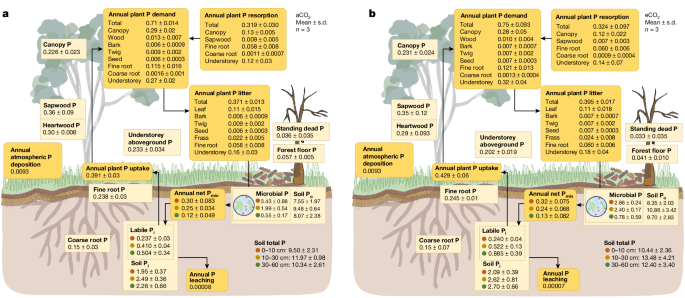Microbial competition for phosphorus limits the CO2 response of a mature forest
IF 50.5
1区 综合性期刊
Q1 MULTIDISCIPLINARY SCIENCES
引用次数: 0
Abstract
The capacity for terrestrial ecosystems to sequester additional carbon (C) with rising CO2 concentrations depends on soil nutrient availability1,2. Previous evidence suggested that mature forests growing on phosphorus (P)-deprived soils had limited capacity to sequester extra biomass under elevated CO2 (refs. 3–6), but uncertainty about ecosystem P cycling and its CO2 response represents a crucial bottleneck for mechanistic prediction of the land C sink under climate change7. Here, by compiling the first comprehensive P budget for a P-limited mature forest exposed to elevated CO2, we show a high likelihood that P captured by soil microorganisms constrains ecosystem P recycling and availability for plant uptake. Trees used P efficiently, but microbial pre-emption of mineralized soil P seemed to limit the capacity of trees for increased P uptake and assimilation under elevated CO2 and, therefore, their capacity to sequester extra C. Plant strategies to stimulate microbial P cycling and plant P uptake, such as increasing rhizosphere C release to soil, will probably be necessary for P-limited forests to increase C capture into new biomass. Our results identify the key mechanisms by which P availability limits CO2 fertilization of tree growth and will guide the development of Earth system models to predict future long-term C storage. Microbial pre-emption of mineralized soil P limits the capacity of trees for increased P uptake and assimilation under elevated CO2 and therefore restricts their capacity to sequester extra C.


微生物对磷的竞争限制了成熟森林对二氧化碳的响应。
随着二氧化碳浓度的升高,陆地生态系统封存额外碳(C)的能力取决于土壤养分的可用性1,2。以前的证据表明,生长在缺磷土壤上的成熟森林在二氧化碳升高条件下封存额外生物量的能力有限(参考文献 3-6),但生态系统磷循环及其二氧化碳响应的不确定性是气候变化条件下陆地碳汇机理预测的关键瓶颈7。在这里,我们首次为暴露在高二氧化碳环境下的P有限的成熟森林编制了全面的P预算,表明土壤微生物捕获的P极有可能制约生态系统P的循环和植物的吸收。树木有效地利用了钾,但微生物对矿化土壤钾的抢占似乎限制了树木在二氧化碳升高条件下增加钾吸收和同化的能力,因此也限制了它们固存额外钾的能力。刺激微生物钾循环和植物钾吸收的植物策略,如增加根瘤层向土壤的钾释放,对于钾受限的森林增加新生物量中的钾吸收可能是必要的。我们的研究结果确定了钾的可用性限制树木生长的二氧化碳受精的关键机制,并将指导地球系统模型的开发,以预测未来的长期碳储存。
本文章由计算机程序翻译,如有差异,请以英文原文为准。
求助全文
约1分钟内获得全文
求助全文
来源期刊

Nature
综合性期刊-综合性期刊
CiteScore
90.00
自引率
1.20%
发文量
3652
审稿时长
3 months
期刊介绍:
Nature is a prestigious international journal that publishes peer-reviewed research in various scientific and technological fields. The selection of articles is based on criteria such as originality, importance, interdisciplinary relevance, timeliness, accessibility, elegance, and surprising conclusions. In addition to showcasing significant scientific advances, Nature delivers rapid, authoritative, insightful news, and interpretation of current and upcoming trends impacting science, scientists, and the broader public. The journal serves a dual purpose: firstly, to promptly share noteworthy scientific advances and foster discussions among scientists, and secondly, to ensure the swift dissemination of scientific results globally, emphasizing their significance for knowledge, culture, and daily life.
 求助内容:
求助内容: 应助结果提醒方式:
应助结果提醒方式:


